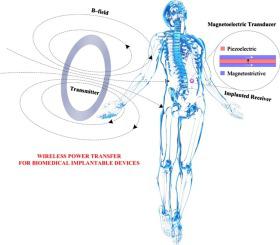Sensors and Actuators A: Physical ( IF 4.6 ) Pub Date : 2020-08-28 , DOI: 10.1016/j.sna.2020.112269 Binh Duc Truong , Erik Andersen , Curtis Casados , Shad Roundy

|
This article presents experimental validation of a generalized equivalent two-port model for a magnetoelectric-based wireless power transfer system (WPTS) that utilizes a circular multi-turn coil as a transmitter, with a focus on potential application to biomedical implantable devices. The central objective of the work is to investigate the performance of the power delivered to a resistive load under uncertainties in magnetoelectric receiver position and orientation. In addition, the effects of a non-uniform applied magnetic field are considered. For the particular experimental system being studied, a maximum transferred power of 4.91 mW is obtained at a distance of 3 cm between the centers of the coil and the magnetoelectric (ME) transducer, in which the corresponding magnetic flux density is 225.8 T. As the distance increases to 6 cm, the generated power drops to 1.97 mW. Furthermore, we find that the output power is proportional to the squared cosine of the misorientation angle, compared to the power achieved at the nominal (zero-angle) position. Meanwhile, as expected, the delivered power is less sensitive to misalignment since the width of the receiver is relatively small in comparison with the diameter of the transmit coil. In general, the power produced at the load is a quadratic function of the effective magnetic field that is projected onto the operating direction of the ME laminated composite (i.e., the longitudinal axis in this case). All findings are expected to provide a universal comprehensive picture of the dynamics and performance of the ME WPTS. The presented device concept could open an alternative pathway for powering implants.
中文翻译:

生物医学植入物的磁电无线功率传输:非均匀磁场,对准和取向的影响
本文介绍了基于磁电的无线电力传输系统(WPTS)的通用等效两端口模型的实验验证,该模型使用圆形多匝线圈作为发射器,重点是对生物医学可植入设备的潜在应用。这项工作的主要目的是研究在磁电接收器的位置和方向不确定的情况下传递给阻性负载的功率的性能。另外,考虑了不均匀施加的磁场的影响。对于正在研究的特定实验系统,在线圈中心与磁电(ME)换能器之间的3 cm距离处可获得4.91 mW的最大传输功率,其中相应的磁通密度为225.8T.随着距离增加到6 cm,产生的功率下降到1.97 mW。此外,我们发现,与在标称(零角度)位置获得的功率相比,输出功率与取向角的平方余弦成正比。同时,如所期望的,由于接收器的宽度与发射线圈的直径相比相对较小,因此所传递的功率对失准的敏感性较小。通常,在负载处产生的功率是有效磁场的二次函数,该有效磁场被投影到ME层压复合材料的工作方向(在此情况下为纵轴)上。预期所有发现将为ME WPTS的动态和性能提供一个通用的综合图。



























 京公网安备 11010802027423号
京公网安备 11010802027423号